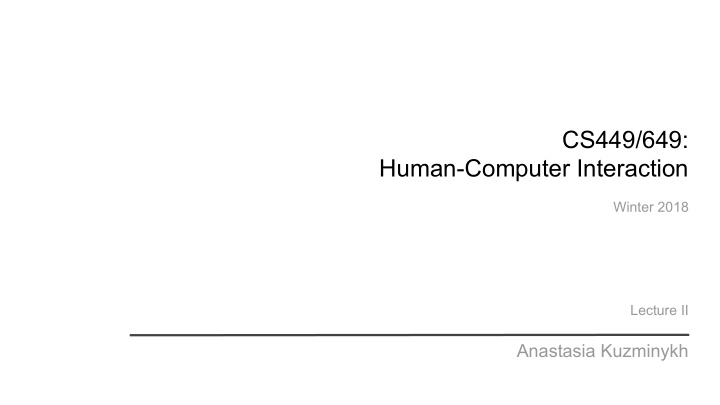



CS449/649: Human-Computer Interaction Winter 2018 Lecture II Anastasia Kuzminykh
Understand Your Users Think about purpose , not technology - allows you to solve a problem , not create a new one - people need to know why they need your product - features are useless without purpose Watch: The art of innovation | Guy Kawasaki
Value Proposition A promise of the value you can deliver; a sharp product definition that highlights the key aspects of it. Assignment 1: Assignment 1: What do you do? How will it help? Description of the Goals and project Hypotheses Assignment 1: Assignment 1: Who is it for? Why you? Target user Description of the groups & project personas
Your Users User groups Personas Set of characteristics Fictional character Based on statistics Based on statistics General Specific
User groups Your Users Set of characteristics Demographics: Other Characteristics: Based on statistics General ● Age & Gender ● Means of transportation Country & Language ● Music preferences ● ● Education ● Hobbies Occupation ● Food preferences ● ● Residence ● Device preferences Income ● Fashion & clothing style ● ● Family status ● Haircuts Size of a family ● Sport preferences ● ● ... ● ...
Personas Your Users Best practice: 3-5 different personas Fictional character Based on statistics Specific ● Persona Group ● Fictional name Important for: ● Job titles and major responsibilities ● Building empathy and relating to users ● Demographics (age, education, family status, etc.) ● Communicating design goals ● The goals and tasks when using the product ● Staying focused of design goals ● Physical, social, and technological environment ● Supporting decision-making Reading: The origin of personas by Alan Cooper
Your Users
Your Users Participants
Your Users Representation of Diverse but user groups generalisable Participants Balanced around How many? key differences
Participants Your Users Why You Only Need to Test with 5 Users by Jakob Nielsen N (1-(1- L ) n ) Where n is a number of users, N is the total number of usability problems, L is the proportion of usability problems discovered while testing a single user. The typical value of L is 31%
Why You Only Need to Test with 5 Users by Jakob Nielsen
Your Users Representation of Diverse but user groups generalisable Participants Balanced around How many? key differences For this course 3-5 participants
Your Users Ethics
Ethics Your Users Why would the university have ethics requirements for a course? Always respect participants! University has a formal process for Ethics. Including their: They consider: ● Time ● Recruitment ● Attitude and environment ● Voluntary participation ● Desire for privacy ● Confidentiality and anonymity ● Risks/benefits ● Fully informed consent Process and protections ensure study is done correctly with proper forethought
Ethics Your Users Principles: Research Ethics Board (REB) at Waterloo can: ● Respect for human dignity ● Approve, reject, propose changes, or terminate any ● Respect for free and informed consent work with human subjects by members of the ● Respect for vulnerable persons university. This includes you . ● Respect for privacy and confidentiality ● REB consists of five members (both men and women) ● Respect for justice and inclusiveness ○ One member knowledgeable in ethics ● Balancing harms and benefits ○ Two members have expertise in fields covered by ● Minimizing harm REB ● Maximizing benefits ○ One member knowledgeable in biomedical law ○ One member from outside university Goal is breadth – want a balanced perspective on projects being examined
Ethics Your Users Voluntariness: Partial consent: Informed Consent: ● Subjects can refuse to answer ● They can consent to all ● Full Disclosure and can stop participating at any or part of process ● Comprehension time ● Consider consent forms ● Voluntariness ● If they say they don’t want to ● Make them aware of ● Competence participate, their involvement is selective exclusion ● Agreement done ● Never, ever push subjects for information they cannot or do not want to disclose
Understanding: Motivations Typical Behaviour Struggles Environment Social context Language ... Exploratory Study
Understand Your Users User study Observe Register Features Ask Questions
Quantitative Qualitative Behavioral ● Fixed & measurable ● Dynamic & descriptive reality reality ● Analyzed numerically ● Analyzed by themes b and statistically a L Field Lab Quantitative Qualitative ● Natural Environment ● Artificial Environment ● Well Controlled ● Uncontrolled Field Attitudina Behavioural Attitudinal l ● What people do ● What people think / feel
Quantitative Qualitative ● Fixed & measurable ● Dynamic & descriptive reality reality ● Analyzed numerically ● Analyzed by themes and statistically Data Triangulation Field Lab ● Natural Environment ● Artificial Environment ● One question - several methods ● Well Controlled ● Uncontrolled ● Cross verification Behavioural Attitudinal ● What people do ● What people think / feel
Understand Your Users: Exploratory Studies Generalizability Trustworthiness of outcomes of measurement Validity of Research Design External Validity Internal Validity
Understand Your Users: Exploratory Studies Generalizability Trustworthiness of outcomes of measurement Validity of Research Design External Validity Internal Validity Selection of the sample Size of the sample Consistency of instruments Experimental Situation Time of the study Reactivity
Understand Your Users: Exploratory Studies Generalizability Trustworthiness of outcomes of measurement Validity of Research Design External Validity Internal Validity Selection of the sample Size of the sample Consistency of instruments Experimental Situation Time of the study Reactivity
Understand Your Users: Exploratory Studies Reactivity Hawthorne (observer) Conformity effect effect Expectancy effect Social desirability (expectancy bias) effect
Understand Your Users: Exploratory Studies Exploratory Study Contextual Cognitive Motivational system knowledge & beliefs (Mental) model
Understand Your Users: Exploratory Studies Exploratory Study Contextual Cognitive Motivational system knowledge & beliefs (Mental) model - A cognitive representation - Goals and tasks (“need”) (understanding) of how - Desirability (“want”) something works / organised - Emotional charge (“fears”, - Based on previous experience & frustration, pleasure, etc.) believes; defines reasoning
Understand Your Users General Goals directions Open mind Hypotheses Exploratory Study There is NO There is a product product
Recommend
More recommend